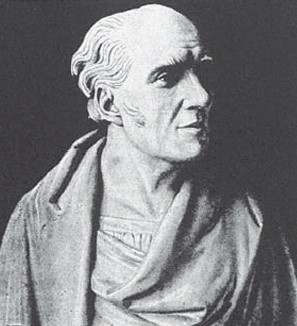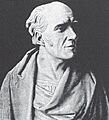James MacDonnell (physician) facts for kids
Quick facts for kids
James MacDonnell
|
|
|---|---|

Bust by Charles Moore, Ulster Museum
|
|
| Born | 14 April 1763 near Cushendall, County Antrim, Ireland
|
| Died | 5 April 1845 (aged 81) Belfast
|
| Education | David Manson's School, University of Edinburgh |
| Occupation | Physician |
| Known for | Founder/patron of the Belfast General Hospital, Belfast Fever Hospital, Linenhall Library, Belfast Harp Society, Belfast Literary Society, Royal Belfast Academical Institution |
James MacDonnell (born April 14, 1763 – died April 5, 1845) was an important Irish doctor and a person with many different skills, known as a polymath. He was very active in the community and political life of Belfast. He helped start many important places that are still around today. These include the Royal Victoria Hospital, the Royal Belfast Academical Institution (a school), and the Linen Hall Library.
He also worked hard to save and promote Irish music and the Irish language. He helped organize the Belfast Harpers Assembly in 1792. Later in his life, some people were upset with him. This was because he offered money for the arrest of his friend, Thomas Russell, who was a rebel.
Contents
Early Life and Education
James MacDonnell was born on April 14, 1763, near Cushendall in County Antrim, Ireland. His father was Michael Roe, a Catholic relative of the Earl of Antrim. His mother was Elizabeth Jane MacDonnell, who was Protestant. James and his two brothers were raised in their mother's Protestant faith.
James first went to a "hedge school" run by Michael Traynor in the Red Bay caves. These were secret schools in Ireland when formal education was limited. He also attended David Manson's unique "play-school" in Belfast. Later, he studied classic subjects with Reverend Nicholas Garnet. He even learned to play the Irish harp from a famous harpist named Arthur O'Neill.
In 1780, when he was 17, James went to Edinburgh University to study medicine. He finished his degree very quickly. His special paper for his degree was about how to help people who had almost drowned. In 1784, he returned to Belfast and started his life there.
Career and Public Contributions
James MacDonnell became a very respected doctor in Belfast. He treated many patients and did his own medical research. He often tried experiments on himself or his friend Thomas Russell. However, he didn't publish much about these experiments.
Helping Public Health
In 1797, MacDonnell helped start the Belfast Dispensary and Fever Hospital. This hospital helped people who were sick, especially with typhus, a common and dangerous illness at the time. It was hard to care for sick people in their homes, so the hospital was very important.
This small hospital moved a few times. In 1817, it became a 100-bed hospital on Frederick Street. This hospital was the beginning of what is now the Royal Victoria Hospital. MacDonnell worked as an "attending physician" there until 1837.
In 1822, MacDonnell and three other doctors helped restart the Ulster Medical Society. In 1835, he was involved in creating the Belfast medical school. This school was connected to the Royal Belfast Academical Institution. MacDonnell had also supported the founding of this school in 1810. He served as a manager and visitor for the school for many years.
Supporting Learning and Culture
MacDonnell was a key figure in Belfast's cultural and intellectual life. On May 13, 1788, he founded the Belfast Reading Society. This society later became the famous Linen Hall Library. He was on the society's committee for a long time and often donated books. He also founded the Belfast Literary Society in 1801 and was its first president.
In 1821, another doctor named Whitley Stokes asked MacDonnell for help with his book. This book was about the people and resources of Ireland. It argued that Ireland's problems were not due to too many people, but because of poor government. MacDonnell also became active in the Belfast Natural History Society in 1832.
Saving Irish Culture
In July 1792, MacDonnell helped organize a big harp festival in Belfast. This event happened at the same time as the town's Bastille Day celebrations. Later, in 1808, James and his brother Alexander started the Belfast Harp Society. They hired their old teacher, Arthur O'Neill, to be the main instructor. The society even had a special school for blind students.
In 1809, with more support from MacDonnell, the society started teaching classes in the Irish language. These classes used a new book to teach the language. The Harp Society and the school closed down around 1812-1813.
In 1830, MacDonnell helped found Cuideacht Gaoidhilge Uladh (the Ulster Gaelic Society). This society worked to promote the Irish language. It was active until 1843. The society believed that trying to convert Catholics to Protestantism had harmed the Irish language.
His Connection to the United Irishmen
Supporting Change and Rights
In 1792, at a town meeting, MacDonnell supported a resolution for Catholic emancipation. This meant giving Catholics more rights. He also connected this idea to ending slavery. Many of his friends at this meeting had formed the Society of United Irishmen. MacDonnell had even hosted their leader, Theobald Wolfe Tone, in Belfast. MacDonnell agreed with the United Irishmen's goal of uniting Irish people of all religions to achieve fair representation in parliament.
However, MacDonnell did not support the Society's later move towards rebellion. He shared this view with his friend Whitley Stokes.
Six years later, in July 1798, Henry Joy McCracken was executed in Belfast for leading a rebellion. When his sister, Mary Ann McCracken, cut him down, she called MacDonnell. She hoped he could bring her brother back to life. MacDonnell, however, sent his brother, John, who was also a skilled surgeon.
The Difficult Decision Regarding Thomas Russell
Thomas Russell had lived with MacDonnell for a time. MacDonnell even helped him get a job as a librarian. After Russell was arrested in 1797, MacDonnell wrote to him. But MacDonnell disagreed with Russell's strong rebel ideas. He thought Russell was sometimes too quick and naive in his political decisions.
In 1803, MacDonnell warned Russell, who was then a wanted man, not to return to Belfast. He said things had changed a lot. When Russell did come back, he found that people were not willing to support a new rebellion. At that time, citizens of Belfast offered a reward for Russell's arrest. MacDonnell contributed 50 guineas (a sum of money) to this reward. He later said he did this to avoid suspicion about himself, as he had to leave Belfast suddenly for an operation. Russell was later caught in Dublin and hanged.
Some of MacDonnell's former friends were very angry and called him a "Judas." The poet William Drennan wrote a poem criticizing him. The botanist John Templeton even left the Belfast Literary Society because he didn't want to be associated with MacDonnell.
However, MacDonnell later worked with William Drennan and other former United Irishmen to found and manage the Academical Institution. This suggests that over time, the hard feelings faded. Templeton met with MacDonnell in 1825 and shook his hand, showing they had made up. Mary Ann McCracken also ended her disapproval of the doctor.
Later Life and Legacy
James MacDonnell was married twice. First, to Eliza Clarke in 1791. They had one daughter and three sons: Katherine Anne, Randal, Alexander, and John. Eliza passed away in 1798. MacDonnell then married Penelope Montgomery.
MacDonnell died at his home in Belfast on April 5, 1845. He is buried in an old churchyard near Cushendall. His grave is marked with a Celtic cross. A poem was written in his memory, and there is a plaque for him near Murlough, County Antrim.
The Ulster Museum has a statue of MacDonnell, and the Royal Victoria Hospital has a painting of him. His personal papers are kept at the Public Record Office of Northern Ireland.
Images for kids


